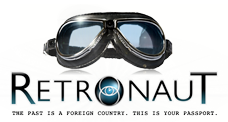While it sounds like a nasty intestinal parasite, Wire Worm is a plugin designed to rid your photographs of pesky unwanted artefacts (particularly wires). Like many modern Photoshop plugins and features, it does a lot of the heavy lifting automatically, calculating the replacement colour /tones and shapes from the surrounding background. And it does a pretty good job, cutting down on the need for fiddling around with endless cloning and other patching techniques.
Photoshop Forges On
Ancient by digital standards, Photoshop continues to reinvent inself. To see how the latest incarnation has changed from those which preceded it, download the temporarily free beta from Adobe, and check out an introductory tour from Lynda.com.
The Past is a Foreign Country
 Looking backwards in time is to be constantly surprised. There's always so much that has been forgotten, and is genuinely strange and unfamiliar Seen in detail, eras often belie their stereotypes. How to be a Retronaut posts themed photo galleries chiefly from any decade of the last ten. Topics include Colour tourist photographs from the Soviet Union (1960s), Harlem Street Scenes (1930s), Pepsi advertisements (1950s), an Apple Gift Catalogue (1983), portraits taken in fake snow (Victorian England) and abandoned buildings of Detroit (2000s) and many, many more. The photographs and ephemera are often hard to contextualise and integrate, yet in an odd way, bring the past momentarily into the present.
Looking backwards in time is to be constantly surprised. There's always so much that has been forgotten, and is genuinely strange and unfamiliar Seen in detail, eras often belie their stereotypes. How to be a Retronaut posts themed photo galleries chiefly from any decade of the last ten. Topics include Colour tourist photographs from the Soviet Union (1960s), Harlem Street Scenes (1930s), Pepsi advertisements (1950s), an Apple Gift Catalogue (1983), portraits taken in fake snow (Victorian England) and abandoned buildings of Detroit (2000s) and many, many more. The photographs and ephemera are often hard to contextualise and integrate, yet in an odd way, bring the past momentarily into the present.
Cooliris
 When installed in your browser, Cooliris converts a standard image search session into a rather more attractive (and possibly more useful) slide show. Google, Bing, Picasa and Flickr image searches are supported (among others). If nothing else, it can make a prosaic image search into a more interactive and almost three dimensional affair.
When installed in your browser, Cooliris converts a standard image search session into a rather more attractive (and possibly more useful) slide show. Google, Bing, Picasa and Flickr image searches are supported (among others). If nothing else, it can make a prosaic image search into a more interactive and almost three dimensional affair.
The Wonder of Very Tiny Things
Much potential aesthetic pleasure is lost because many objects of beauty are too small for our underpowered eyes to clearly see. But when we use lenses, stains and modern scanning devices, we can see ornate biological forms, pristine crystal structures and intriguing chemical reactions. Nikon celebrates the convergence of beauty and knowledge in a fascinating online gallery.
Stars in Your Eyes
 As a child, I was disappointed to discover that only a couple of thousand stars were visible to the naked eye. With the encroachment of light pollution, that figure is probably rather optimistic. Uber-enthusiastic amateur astronomer Nick Risinger decided to create a massive full sky image combining thousands of images -- the night sky we wish we could see. For optimum viewing, he travelled tens of thousands of kilometres to seek out the darkest parts of the US. The results are awe-inspiring. Our own galaxy extends from edge to edge in a blaze of starry glory, with lanes of gas and companion star clusters clearly visible. He has made large versions (3000 pixels wide) available to the public, plus selling prints on archival stock.
As a child, I was disappointed to discover that only a couple of thousand stars were visible to the naked eye. With the encroachment of light pollution, that figure is probably rather optimistic. Uber-enthusiastic amateur astronomer Nick Risinger decided to create a massive full sky image combining thousands of images -- the night sky we wish we could see. For optimum viewing, he travelled tens of thousands of kilometres to seek out the darkest parts of the US. The results are awe-inspiring. Our own galaxy extends from edge to edge in a blaze of starry glory, with lanes of gas and companion star clusters clearly visible. He has made large versions (3000 pixels wide) available to the public, plus selling prints on archival stock.
Vectors Online
 One of the interesting aspects of cloud computing are programs that run over the web rather than residing on your PC. Examples include Google Documents, Google Calendar, online accounting solutions and online databases. Other programs install on your computer, but run on a constant stream of data from the web, such as Google Earth, or are strongly integrated with the web, such as Picasa. Google Docs and Calendar have fairly limited capabilities compared to programs that reside on a single PC, mostly due to limitations of bandwidth.
In the graphics field, the tentative beginnings of a revolution may be underway. A company named Aviary is offering a suite of programs available online, no installation required. The programs include both an image editor and a vector drawing editor. The drawing tools are frankly primitive compared to those available in Illustrator or CorelDRAW. The fundamental interface is very similar, and it could prove a useful introduction to people learning to use vector packages. As a pointer to the future, however, it is very interesting indeed. If a user could access a professional standard drawing package online, would it make sense any more to install it on your machine (assuming reliable internet service provision)? Updates and improvements would be instantly available to the user, projects could be stored and distributed online, and collaboration and file sharing would be much easier. The same reasoning would apply to photo editing packages and even page layout programs.
The financial model would be subscription or membership based, with some offerings perhaps free in return for advertising placement. Bandwidth would have to improve dramatically for this to become a reality. Barriers to entry for new software providers would be much lower. Personal computers would become windows to a much larger realm rather than kingdoms in their own right. Perhaps the only role for the home computer would be to mirror the data generated online in as a form of insurance. Perhaps each of the programs to which the user subscribes could have an offline version for moments where the web is unavailable, resynchronising when the connection is restored.
One of the interesting aspects of cloud computing are programs that run over the web rather than residing on your PC. Examples include Google Documents, Google Calendar, online accounting solutions and online databases. Other programs install on your computer, but run on a constant stream of data from the web, such as Google Earth, or are strongly integrated with the web, such as Picasa. Google Docs and Calendar have fairly limited capabilities compared to programs that reside on a single PC, mostly due to limitations of bandwidth.
In the graphics field, the tentative beginnings of a revolution may be underway. A company named Aviary is offering a suite of programs available online, no installation required. The programs include both an image editor and a vector drawing editor. The drawing tools are frankly primitive compared to those available in Illustrator or CorelDRAW. The fundamental interface is very similar, and it could prove a useful introduction to people learning to use vector packages. As a pointer to the future, however, it is very interesting indeed. If a user could access a professional standard drawing package online, would it make sense any more to install it on your machine (assuming reliable internet service provision)? Updates and improvements would be instantly available to the user, projects could be stored and distributed online, and collaboration and file sharing would be much easier. The same reasoning would apply to photo editing packages and even page layout programs.
The financial model would be subscription or membership based, with some offerings perhaps free in return for advertising placement. Bandwidth would have to improve dramatically for this to become a reality. Barriers to entry for new software providers would be much lower. Personal computers would become windows to a much larger realm rather than kingdoms in their own right. Perhaps the only role for the home computer would be to mirror the data generated online in as a form of insurance. Perhaps each of the programs to which the user subscribes could have an offline version for moments where the web is unavailable, resynchronising when the connection is restored.
